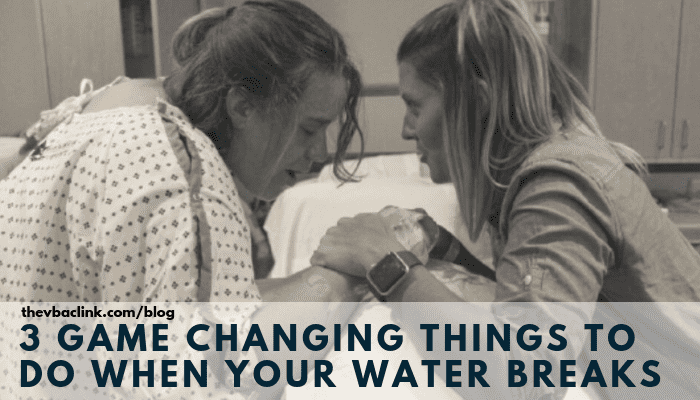Between Meagan and I’s 7 pregnancies, 5 of them have started with our water breaking spontaneously before active labor.
Otherwise known as PROM (premature rupture of membranes), it actually only happens in 8% of term pregnancies and labor typically starts within 24-46 hours of water breaking (Gunn, et al, 1970).
We LOVE this article from Evidence Based Birth all about PROM and you can get all your data and details there however, in this blog, we want to share three things you can do AFTER your water breaks and BEFORE labor begins to up your chances of having a vaginal birth.
First of all, listen to the advice of your provider based on your unique circumstance but know that each provider differs, sometimes drastically, in their opinion and instruction with how to handle PROM.
As always, trust your gut, and get a second opinion if you feel like something isn’t quite right. Also, if you tested positive for Group B Strep (GBS), these recommendations may not apply based on how you have decided to manage that.

1. Rest, Rest, Rest
The very best thing you can do after your water breaks is try and sleep.
It feels so counterproductive and might even seem impossible because you are SO excited things are happening but trust us, especially if your labor ends up lasting a long time, you are going to want to go into it well rested. You need that energy!
Bonus: Sleep increases the natural production of the oxytocin hormone which is exactly what you need to get things moving right along.
2. Get That Baby in a Good Position
If you don’t know what position your baby is in or, if you just know that he/she is head down, do exercises and techniques like The Miles Circuit and Spinning Babies to nestle baby into an LOA or OA position to help labor progress nice and smooth.
If your baby’s head is tilted or baby is facing posterior, it will make it harder for the little one to descend.
Even better? Settle in to the Exaggerated Side Lying position from the Miles Circuit for a nice long nap.
3. Avoid Routine Cervical Checks and Watch your Temperature
The biggest thing to watch for, after water breaks, is that there is no increased risk of infection to the baby. A woman’s vagina is not a vacuum, things do not get sucked in.
The best way to avoid exposure to unnecessary bacteria is to avoid things like frequent cervical checks and intercourse.
Watch your temperature. If you feel like you are getting feverish or the chills or a general feeling of being unwell, it would be a great idea to check in with your provider or head to the hospital.
While rare, infection getting through the birth canal and in to the baby does happen and is cause for concern and attention.
Other than that, just relax and get ready to meet you baby! As long as your temperature is stable and you have no health concerns, it is ok to wait for labor to start on its own.
Listen to episode 42 of our podcast to hear Mary’s story of a successful VBAC after waiting for 60 hours for her labor to start after her water broke.
Want to be fully prepared for your upcoming VBAC? Register today for our Ultimate VBAC Prep Course for Parents, and deliver your baby with confidence.













 Why Babies Go Breech and 5 Things You Can Do About It
Why Babies Go Breech and 5 Things You Can Do About It